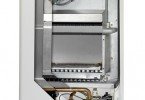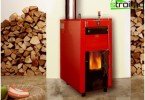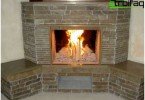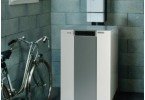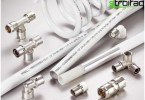Radiators (batteries) for heating
Without heating, coziness and comfort in the house is unthinkable, and batteries are the most important element of the heating system. The article will tell you how modern radiators are similar and how they differ: how to choose the best radiators for your home or apartment – efficient, energy-saving, not violating the harmony of the interior.
Content
- Convection or radiation?
- The choice of radiators for water heating
- New options from the “old” cast iron
- Aluminum sectional radiators
- Bimetal batteries with sections
- Steel panel radiators
Convection or radiation?
It is impossible to say unequivocally which heating batteries are better: when choosing a device, it is necessary to take into account the individual characteristics of the room and its heating system.
All heating systems using radiators work according to one simple principle: the heat carrier – water or gas – is heated in the boiler room and piped to the heater in the room. The heater is a battery that heats the room air..
There are two ways to transfer heat from radiators – convection and radiation..
Convection, natural or forced, is the accelerated heating of air in contact with the developed heating surface of the heating battery. On the principle of forced convection, the work of convectors – heating appliances, the construction of which is integrated with a fan.
Convectors can heat a room very quickly, but they also have a significant drawback. Active convection of air, like a vacuum cleaner, dries the air too much and carries away a large amount of dust, which does not contribute to a healthy microclimate in the house. Usually this type of heating devices is used in problem rooms with large areas of glazing, where conventional heating devices violate the harmony of the interior.
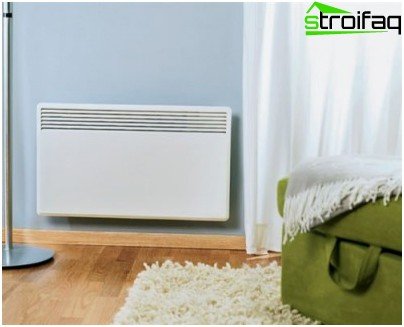
Convectors are recommended to be installed in problem rooms with large areas of glazing
Radiation is the natural heating of the air in a room by the surface of a heating device – a radiator, which has increased heat capacity and temperature. Radiation accounts for about 60% of the thermal energy given by radiators to the space of the room, and only the remaining 40% is due to natural convection due to the movement of air masses in the room.
Thus, radiator heating, due to minimal convection of hot air, is environmentally friendly and closest to heating by a stove or underfloor heating. There are also combined heaters – panel radiators, convectors.
The choice of radiators for water heating
The modern market offers several types of radiators (batteries) for water heating, differing in size, weight, heat transfer capacity, heat loss, material of manufacture and design. Therefore, before choosing heating batteries, it is necessary to clarify the priority parameters for your house or apartment and, depending on them, choose one or another type of radiator.
It is important to remember:
- The power of the heating batteries is selected based on the following room heating standard: 100 W per square meter of room area with one eye and one external wall.
- For a room with two windows and two exterior walls, an additional 30% should be added to the rated power.
- If the radiators will be closed with decorative panels, another 15% will have to be added to the received power value.
- Also, 5-10% are added to the calculated value of the thermal power of the batteries, if they are located in niches or the windows of the room face north or northeast. If several factors coincide, additional percentages add up.
In the heating systems of modern cottages and apartments, the following types of radiators are used, differing in the material of manufacture:
- cast iron;
- steel;
- aluminum;
- bimetallic.
Design features of water heating radiators are presented in two groups:
- sectional – these are cast-iron, aluminum and bimetallic radiators;
- panel – they are represented by steel radiators.
New options from the “old” cast iron
Reliability and practicality cast iron radiators well known to domestic consumers. They are characterized by high corrosion and abrasion resistance, and serve for at least 50 years. In heating systems with low quality coolant, the question “which radiators to choose” is almost not posed: the answer will be in favor of cast-iron radiators
Cast iron radiators are also ideal for solid fuel heating systems. Due to the thick walls, the large capacity of the sections (up to 1.4 l) and the physical properties of cast iron, they are able to accumulate a large amount of heat and provide space heating in between the loads of the solid fuel boiler.
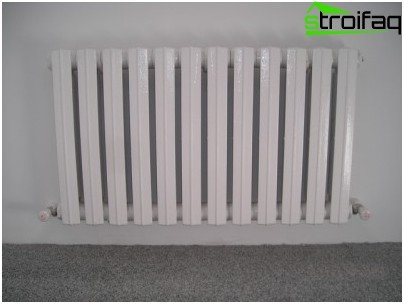
Inertial, durable and reliable cast-iron radiators are chosen for cottages and apartments with heating systems that are not equipped with automation
Cast iron radiators are mainly designed for a pressure in the system of 6-9 atm and a maximum coolant temperature of up to 130 ° C, but due to their high heat capacity they are characterized by high thermal inertia: they heat the room for a long time and slowly cool down.
Because of this feature, they are not suitable for heating systems equipped with automation, since they will not be able to provide, for example, a heating mode with a day temperature of 22 ° C and a night temperature of 17 ° C.
Aluminum sectional radiators
Spectacular in design, lightweight, less heat-consuming, but quickly radiating heat into the space, sectional radiators made of aluminum are a worthy alternative to inertial cast-iron counterparts. The fins around the main channels enhance the natural convection of air in them, so that dust does not accumulate on aluminum batteries, and the low inertia of this type of heating device allows you to quickly change the temperature in accordance with the commands of the control thermostats.
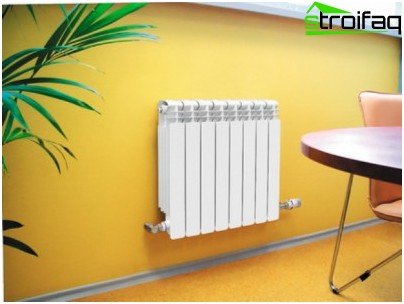
Low-inertia aluminum radiators allow you to quickly change the temperature in accordance with the commands of thermostats control
However, along with the undeniable advantages, there is also a drawback that must be considered before choosing the right aluminum heating radiators. The fact is that aluminum is sensitive to the quality of water in the heating system: the optimum acidity should correspond to a pH value of 7-8. The electrochemical corrosion rate of aluminum is affected by stray currents in the building, which is part of the additives to reduce water hardness, oxygen, as well as the installation of aluminum heating devices in one system with copper and steel parts and pipes.
To prevent destructive electrochemical reactions, the use of special dielectric adapters at the junction of aluminum sections with copper or steel pipes and parts is recommended. The pressure drops that are characteristic of Russian urban heating systems are also undesirable for aluminum radiators, but a number of manufacturers offset this drawback by starting production aluminum radiators with working pressure up to 16 atm.
Bimetal batteries with sections
Those who have not yet decided which heating batteries to choose, since cast iron or aluminum did not fit in one or another parameter, should look at the elegant and powerful bimetallic sectional radiators. Heating devices of this type are structurally a system of vertical steel tubes, which are filled in from the outside by suppression with a special aluminum alloy. As a result, bimetallic batteries, thanks to the physical properties of steel, perfectly withstand high heat carrier pressure and resist corrosion, and the aluminum surface perfectly transfers heat and quickly heats the room.
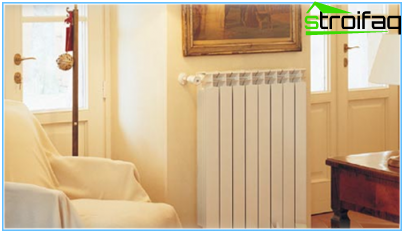
Bimetallic batteries perfectly withstand high pressure coolant, resist corrosion and quickly heat the room
Bimetallic radiators are designed for an internal working pressure of a coolant of 25 atm and are free from the disadvantages of cast iron and aluminum analogues, but they have a small drawback – a reduced volume of circulating water due to the small cross-section (only 12-15 mm) of the inner steel tubes. To quickly heat the room and then maintain the optimum temperature, the coolant must constantly circulate in the system at a high speed, and this may be accompanied by a characteristic whistle in the heads of thermostats.
Steel panel radiators
By thermal conductivity, panel steel radiators can be installed between cast iron and aluminum counterparts. Panel batteries are made from corrosion-resistant stamped steel sheets and structurally they are a series of parallel vertical channels connected by a horizontal collector. They are single, double and triple-row, with or without finning, and the outer panels are covered with heat-resistant multilayer enamel.
Steel radiators are designed for a working pressure of 6-10 atm and a maximum coolant temperature of up to 120 ° C. Compared to a cast-iron battery, a steel panel radiator is characterized by high energy-saving properties: it is able to give as much heat as a cast-iron battery by using 7 times less water with a temperature of 20 ° C lower. In addition, thanks to the developed heat exchange surface, he heats the room faster, since he does not spend heat on heating himself.
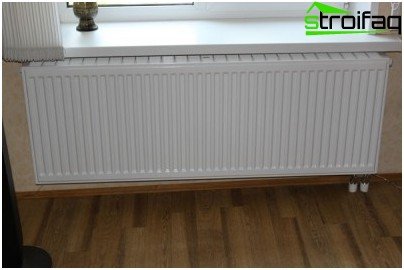
Steel panel radiators reduce energy costs for heating
The steel panel radiator is characterized by a large internal volume compared to a bimetallic analogue and, not requiring continuous circulation of the coolant, surpasses it. The disadvantage of steel panel radiators is their short service life – no more than 15 years.
When deciding how to choose the right heating battery, it is necessary to take into account the installation location, the area of the room, the quality of the coolant in the heating system. So, for example, for a cottage equipped with an automatic heating system, steel panel radiators are suitable, and if automation is not provided, they are good cast iron. For apartments in new high-rise buildings with high pressure and low water quality, bimetal batteries are ideal in heating systems. If the water quality in the heating system of the apartment is satisfactory, you can stop the choice with aluminum batteries, making sure that the pressure in the system does not exceed the rating values of the device. If the old heating system of the apartment needs reconstruction, replacing cast iron batteries with panel steel will help reduce energy costs.


